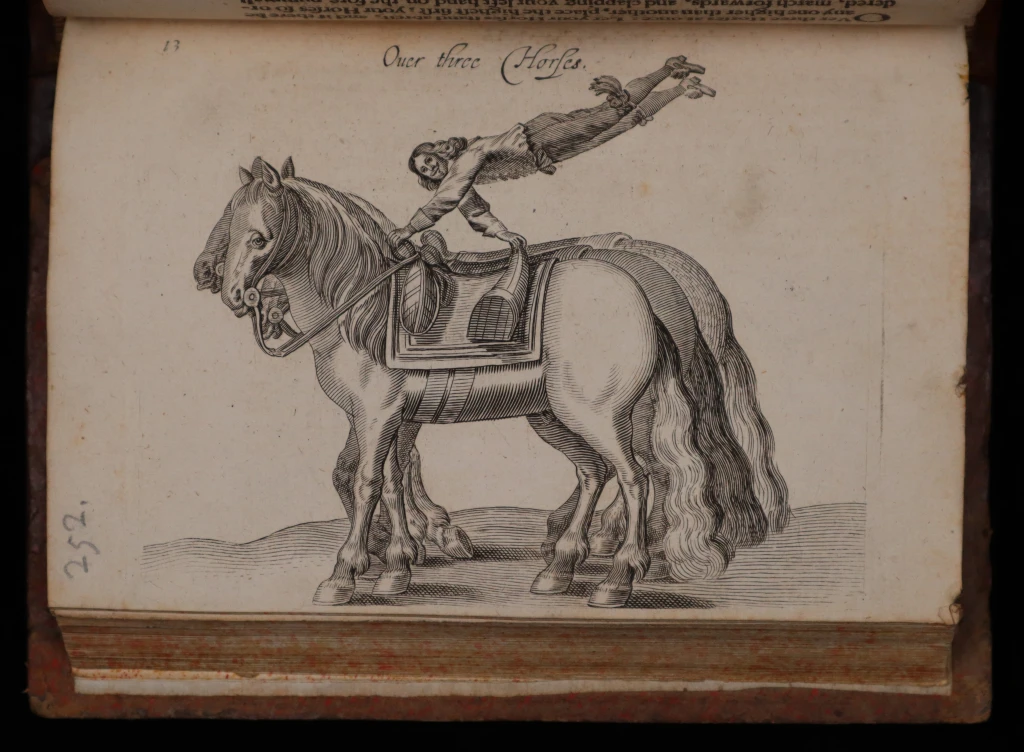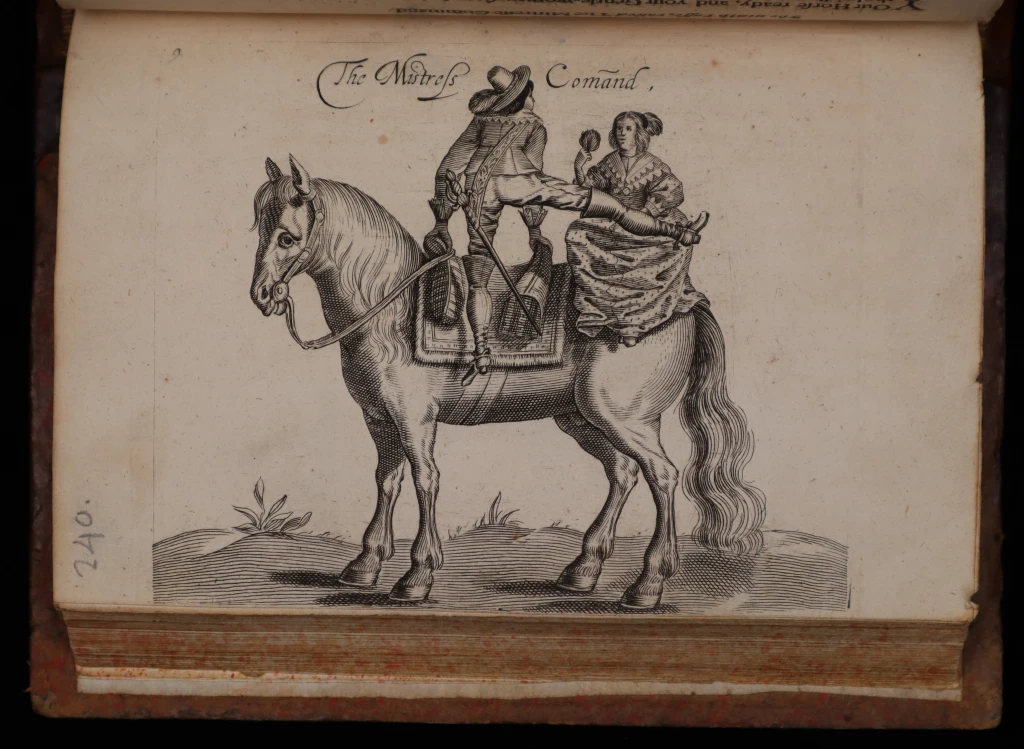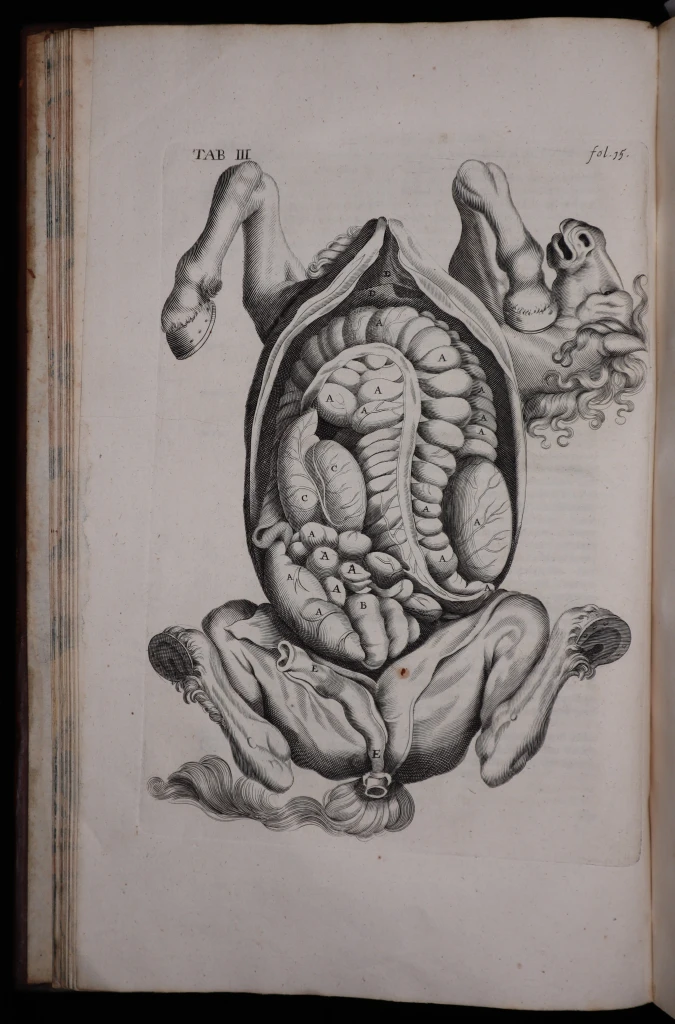Library and Archives
Pepys and Horses
In the seventeenth century, horses were essential for travel and transport.
Horses carried farm produce to and from market for agricultural workers, while the middle to upper ranks of society relied on horse riding and horse-drawn coaches for daily activities. In his diary, Pepys often travelled by horseback or horse-drawn coach for work and leisure. Until 1668,[i] Pepys did not own his own horse but hired them for himself and on behalf of others. He was appreciative of horses which “[rode] very well” and were “pretty”.[ii] For the most part, Pepys rode “good horses” that made “good way”,[iii] however he also complained about their unpredictability. For example, when riding in the park amid “a throng of horses […] my stone-horse was very troublesome and begun to fight with other horses, to the endangering him and myself”. Fortunately, Pepys proudly recollected keeping himself “out of harm’s way”.[iv] The same could not be said for the lawyer, Sir John Glynne, “whose Horse fell upon him yesterday and is like to kill him”.[v] Of further frustration to Pepys was when taking a coach home, “the horses were tired and would not carry us further then St. Dunstans”. Instead, Pepys and his clerk, Will Hewer, were forced to walk.[vi]

Pepys makes no reference to going hunting or watching horse-racing in his diary, although Charles II and his court loved attending the “great horse-race” at Newmarket.[vii] Nonetheless, Pepys appears to have enjoyed the thrill experienced when travelling by horse at speed. 0n 29 May 1661, Pepys imagined himself competing in an ancient Olympic chariot race, (the tethrippos), writing: “In our way we had great sport to try who should drive fastest, Sir W. Batten’s coach or Sir W. Pen’s charriot, they having four and we two horses, and we beat them”.[viii] Despite winning, Pepys was annoyed that the race spoilt dirtied his clothes and velvet coat.[ix]

Amongst the upper ranks, horse ownership was a status symbol which also served a practical purpose. A proud moment for Pepys was purchasing a fine “pair of black coach-horses”, costing 50 pounds[x] in December 1668 (the equivalent to £10000 in today’s money[xi]). On his first outing to Hyde Park with his new horses three months later, Pepys boasted that amongst “the many coaches […] I thought oure horses and coach as pretty as any there, and observed so to be by others.”[xii] It is clear that Pepys was deeply concerned about how his horses were perceived by others, as it signalled his increasing social status.

There are books about horses in the Pepys library, including one about vaulting, a seventeenth-century sport to perform tricks on a living horse. Today, we may think of vaulting in terms of gymnastics, where the gymnast performs on a ‘vaulting horse’. In William Stokes, The Vaulting-Master: Or, the Art of Vaulting, the author claims to be “the first of any”[xiii] to methodize the art of vaulting in print. Moreover, he declares himself “amongst all the excellent Professours of this Art”, due to his near-thirty years of practice and experience.[xiv] The pamphlet is illustrated with fifteen engravings, accompanied by instructions for each of the vaulting exercises. Each move or “Passe” has a name, for example: “The Hercules Leape”, “which require great strength, and is not done by an ordinarie man”[xv]. There are even instructions outlining how to vault “Over three Horses at once”[xvi], and one demonstrating how to vault over a gentlewoman seated on the horse, “without molesting her”[xvii]. Although there is no evidence that Pepys tried vaulting, his close friend, John Evelyn attended Stoke’s vaulting school in Oxford in 1638.[xviii]
Another horse-related book in Pepys’ collection concerns equine anatomy. Written by Andrew Snape, Junior Farrier to Charles II, the treatise is intended to “instruct Farriers in the Frame, Situation and Use of the Parts of an Horse”, so they become “more skilfull in applying and administring proper Remedies”.[xix] The book is divided into sections illustrating the different parts of the body, including “the Lowest Belly or Paunch”, “the Middle Venter, or Chest”, “the Uppermost Venter, or Head”, “the Muscles” and “the Bones”[xx]. The level of detail in the engravings demonstrates the advancement of anatomical knowledge in the seventeenth century.
Horse ownership in the seventeenth century was not purely for companionship or sporting endeavour, and they played an important practical role in all levels of both rural and urban society. Nonetheless, amongst the elite, owning high-quality horses was a status symbol which Pepys was “mighty proud of”[xxi].
Copies of The Vaulting-Master and The Anatomy of an Horse from other libraries have been digitised by Internet Archive and can be viewed via these links free of charge.
By Isobel Renn
Pepys Library Assistant and Invigilator
All images used in this blog are the copyright of the Pepys Library, Magdalene College Cambridge. To reproduce these images in any format, including online, permission from the College must be sought.
References
[i] Pepys, Samuel, The Diary of Samuel Pepys: A New and Complete Transcription, Vol. 9: 1668-69, ed. by Robert Latham and William Matthews (London: G. Bell and Sons, 1971), p. 392.
[ii] Ibid., Vol. 2: 1661, p.180.
[iii] Ibid., Vol 2: 1661, p. 15.
[iv] Ibid., Vol 4: 1663, p. 120.
[v] Ibid., Vol. 2: 1661, p. 87.
[vi] Ibid., Vol 2: 1660, p. 209.
[vii] Ibid., Vol 9: 1668-69, p. 209.
[viii] Ibid., Vol 2: 1661, p. 110.
[ix] Ibid., Vol 2: 1661, p. 110.
[x] Ibid., Vol 9: 1668-69, p. 392.
[xi] Bank of England, Inflation Calculator, (n.d.) < https://www.bankofengland.co.uk/monetary-policy/inflation/inflation-calculator>%5Baccessed 19 June 2024].
[xii] Pepys, Samuel, Diary, Vol 9: 1668-69, p. 487.
[xiii] Stokes, William, The Vaulting-Master: Or, the Art of Vaulting: Reduced to a Method, comprized under certaine Rules, Illustrated by Examples, And Now primarily set forth, by Will: Stokes. For Richard Davis, in Oxon, 1652, f. a3v.
[xiv] Ibid., f. a3v.
[xv] Ibid., f. C4v.
[xvi] Ibid., f. D3.
[xvii] Ibid., f. Dr.
[xviii] Manning, Percy, ‘William Stokes, Vaulting-Master’, The Oxford Magazine, 31 (1912-3), 229-30, p. 229.
[xix] Snape, Andrew, The Anatomy of an Horse. Containing An exact and full Description of the Frame, Situation and Connexion of all his Parts, (with their Actions and Uses) exprest in Forty nine Copper-plates. To which is Added an Appendix, Containing two Discourses: The one, of the Generation of Animals; And the other, of the Motion of the Chyle, and the Circulation of the Bloud. (London: Printed by M. Flesher for the Author, and are to be sold by T. Flesher at the Angel and Crown in S. Paul’s Church-yard. An Dom., 1683), f. A3v.
[xx] Ibid., pp. 1-237.
[xxi] Pepys, Samuel, The Diary of Samuel Pepys, Vol 9: 1668-69, p. 397.